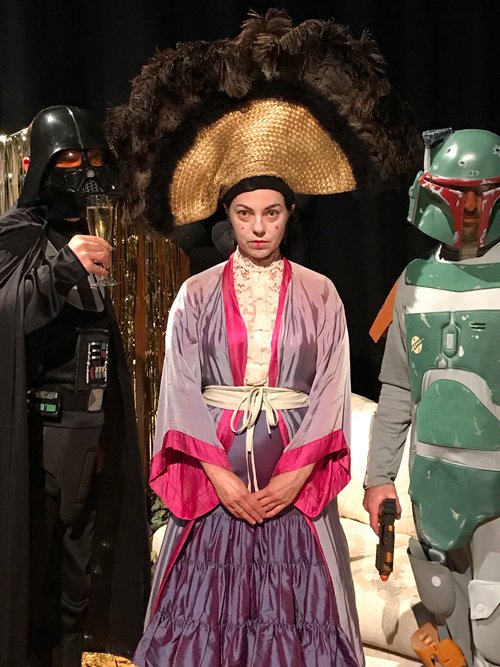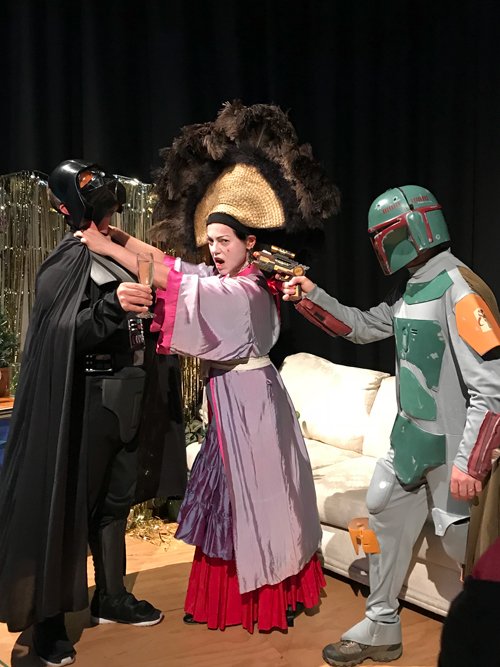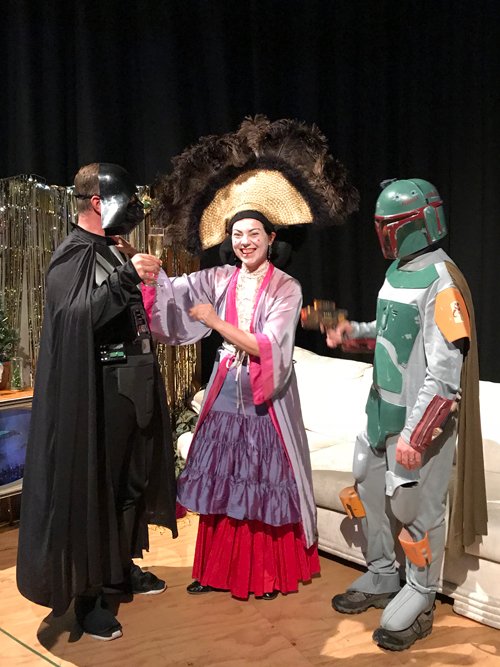Archive
- Behind the Screens 9
- Bright Young Things 16
- Colour Palette 64
- Dress Ups 60
- Fashionisms 25
- Fashionistamatics 107
- Foreign Exchange 13
- From the Pages of… 81
- G.U.I.L.T. 10
- Little Trifles 126
- Lost and Found 89
- Odd Socks 130
- Out of the Album 39
- Red Carpet 3
- Silver Screen Style 33
- Sit Like a Lady! 29
- Spin, Flip, Click 34
- Vintage Rescue 20
- Vintage Style 157
- Wardrobe 101 148
- What I Actually Wore 163
What I Actually Wore #0138
 Serial #: 0138
Serial #: 0138
Date: 15/08/2013
Weather: 18°C / 64°F
Time Allowed: 10 minutes
Often my winter outfits start out by assessing the forecast temperature, and whether I can be bothered wearing tights. Usually the answer is ‘no’ to that question (I generally hate tights). I then toss up between over-the-knee socks (will they keep me warm?) and trousers (do I feel like wearing pants, and if I do, which length will work with comfortable walking shoes? … I should draw an infographic for this process!). This morning, these wool-blend OTK socks were appealing, although according to my notes I wore the dark brown pair, not the beige ones in the photograph.
When I saw [the suit] in the boutique I was immediately enamoured of the jacket because of the sleeves.
I chose the Spanish designer suit I bought as a souvenir from Sitges, in the northern Catalonian region in Spain a couple of years earlier. When I saw it in the boutique I was immediately enamoured of the jacket because of the sleeves. There are various influences at play: vaguely Renaissance-look sleeves, a Regency cropped length, a Mandarin collar and cheongsam-inspired fastening – a very interesting mix! I would have preferred a longer waist-length however as the crop can make it difficult to wear.
I also love the herringbone fabric, a type of tweed that always fools me into thinking it is winter weight, but in fact it is a linen/viscose blend. As it was a cool day, I also wore my 1970s suede Zhivago coat on top.
Although even on the half-off sale, the suit was a splurge, I still – five years on – have it hanging in my closet.
 Underneath I am wearing a wool/silk knit. Out of the accessories, only the raspberry suede peeptoes have survived – the very soft socks sadly wore out to the point the feet were nothing but darns (although I still have the dark brown version and wore them last week in fact), and the modern fedora has a nicer vintage 1970s successor. I still have all the jewellery too. As for the sunglasses … I look at them now and hate them! I instantly thought ‘fly’s eyes’! If I find they are still in the box I store my plethora of sunglasses in, they shall be immediately expelled.
Underneath I am wearing a wool/silk knit. Out of the accessories, only the raspberry suede peeptoes have survived – the very soft socks sadly wore out to the point the feet were nothing but darns (although I still have the dark brown version and wore them last week in fact), and the modern fedora has a nicer vintage 1970s successor. I still have all the jewellery too. As for the sunglasses … I look at them now and hate them! I instantly thought ‘fly’s eyes’! If I find they are still in the box I store my plethora of sunglasses in, they shall be immediately expelled.
I’m pleased to also read in my notes that I received lots of compliments for this outfit – at work, on the street and in the theatre when I went out in the evening. If I wore it today, I probably would not style it very differently.
Items:
Suit: Celia Velo
Top: secondhand
Socks: Philippe Matignon
Hat: Milana
Earrings: Baku (now defunct)
Ring: Autore
Watch: Kenneth Cole
Sunglasses: MinkPink
Shoes: Wittner
Photos: Septemer 2013
Star Wars Day
 Padmé Amidala, Queen of Naboo, would like to wish you Happy Star Wars Day! Granted, she doesn’t look very happy but lots of horrible things happened to her: (spoiler alert) her planet was being invaded, her husband turned into Darth Vader, and finally she died in childbirth.
Padmé Amidala, Queen of Naboo, would like to wish you Happy Star Wars Day! Granted, she doesn’t look very happy but lots of horrible things happened to her: (spoiler alert) her planet was being invaded, her husband turned into Darth Vader, and finally she died in childbirth.
I wore this costume, remarkably cobbled together from items of clothing I actually own, to my work’s Christmas party last year. I work at a theatre, so as you can imagine, most people go all-out for our annual dress-up and try to out-do one another with mostly stellar results. Every year we are given a theme, and last year it was ‘Out of this World’. I immediately decided on the Queen of Naboo, with one restriction laid on myself: to create the costume without spending any (or very little) money.
I knew the most difficult part to recreate would be the hair, and after very little searching for Geisha-style wigs I quickly discovered what a paucity of options there were on offer. I decided that I would have to be creative.
While I left that on the backburner, I turned my attention to the other parts of the costume. You might have thought the headdress would be a stumbling block, but that was easy – naturally I had an enormous feathered hat (once featured in Australian Vogue magazine in the 90s) on hand.
You might have thought the headdress would be a stumbling block, but that was easy …
As for the rest: the gorgeous Chinese silk lace blouse was a recent purchase in a thrift store, and the vintage kimono was a souvenir I had bought in Vietnam many years ago from an antique store. The leather obi I bought new when obis were all the rage in mainstream fashion a decade or two ago.
Two vintage silk skirts layered provided the sumptuousness of Queen Amidala’s wardrobe, and were also purchases from thrift stores. The shot-silk blue skirt is probably 80s, and the red skirt (beautifully constructed) is I think a 70s number. Underneath I wore white socks and black leather ballet flats.
 Queen Amidala’s makeup is iconic, and immediately pulls the whole ensemble together – that’s where I spent a small portion of my $15 total, on white face makeup. As for the wig: I decided to utilise a pair of black wool tights, stuffed with polyester hobby filler (the other portion of my spending) and twisted into a fanciful shape. I tried ordinary opaque tights, but the lighter fibres proved to be transparent, so I had to bring out the big guns. The wig is quite heavy and clumsy, and the hat precariously balanced, but good enough for the few hours of a costume party. (That’s when a queenly deportment comes in handy – no slouching!)
Queen Amidala’s makeup is iconic, and immediately pulls the whole ensemble together – that’s where I spent a small portion of my $15 total, on white face makeup. As for the wig: I decided to utilise a pair of black wool tights, stuffed with polyester hobby filler (the other portion of my spending) and twisted into a fanciful shape. I tried ordinary opaque tights, but the lighter fibres proved to be transparent, so I had to bring out the big guns. The wig is quite heavy and clumsy, and the hat precariously balanced, but good enough for the few hours of a costume party. (That’s when a queenly deportment comes in handy – no slouching!)
I caused a sensation at the office party; one of the most amusing aspects was having to move sideways through the crowds, lest I took someone’s eye out with my hat! There was also a couple of Darth Vaders and a Boba Fett, so there was plenty of opportunity for Imperial high jinks.
May the Fourth be with you!
Photos: Yesterday
~
Scroll down for some party pics.
 Getting ready in the office bathroom (you can see the rear view in the mirror).
Getting ready in the office bathroom (you can see the rear view in the mirror).  Queen Amidala always looks so solemn, but her planet IS being invaded after all!
Queen Amidala always looks so solemn, but her planet IS being invaded after all! Oh, Anakin! How could you!?
Oh, Anakin! How could you!?  Apparently I don't know my own strength – I actually nearly strangled poor Darth. Luckily he was forgiving, or maybe that was the sparkling wine.
Apparently I don't know my own strength – I actually nearly strangled poor Darth. Luckily he was forgiving, or maybe that was the sparkling wine.
Easter Soufflé
 Sadly, there aren’t too many millinery traditions upheld at Easter these days, except perhaps in the classroom, where children still construct Easter bonnets. So this Good Friday, I bring you a robin’s egg blue soufflé!
Sadly, there aren’t too many millinery traditions upheld at Easter these days, except perhaps in the classroom, where children still construct Easter bonnets. So this Good Friday, I bring you a robin’s egg blue soufflé!
This vintage 1960s glorified beret has so many enjoyable points: it’s striped; it’s robin’s egg blue (or, if you like, Tiffany blue, one of my favourite colours); and is has an amusing amount of volume. That latter characteristic is why I’ve dubbed it my soufflé hat. It can, however, be flattened to a less conspicuous and more omelette-type shape if I want to go about incognito.
So many eggscellent reasons to wear it at Easter time!
Photo: April 2013
Please to Meecha, Bombacha!
 A new kind of trouser has travelled upriver to the West in the last few years, and entered the mainstream. The first ripples came in the guise of the harem pant, ballooning from the waist; yards of fabric gathered at the ankle. Gradually the form took on a different silhouette, less billowy in the leg, and the new trouser shape became inelegantly known as the ‘drop crotch’. As I own a few pairs, curiosity lead me on a journey to discover the origins of these comfortable trousers.
A new kind of trouser has travelled upriver to the West in the last few years, and entered the mainstream. The first ripples came in the guise of the harem pant, ballooning from the waist; yards of fabric gathered at the ankle. Gradually the form took on a different silhouette, less billowy in the leg, and the new trouser shape became inelegantly known as the ‘drop crotch’. As I own a few pairs, curiosity lead me on a journey to discover the origins of these comfortable trousers.
In South America it is more traditionally known as the bombacha, or the gaucho, and the trouser takes its name from the South American equivalent of the cowboy. Today they are worn for riding or for outdoor work that requires sturdy garb. The trousers are long, loose and baggy, and are usually tucked into boots to create the look more familiar to us on the runway. Some modern versions of the bombacha are cropped just past the knee for practicality.
 Traditional guachos
Traditional guachos
Loose, comfortable trousers have been worn throughout history by both men and women around the world.
Loose, comfortable trousers have been worn throughout history by both men and women around the world. A similar style of trouser has long been worn in South and Central Asia, where they are known as shalwar kameez. They are also part of Turkish folk costume, and are called şalvar in Turkish, while historically Persian horsemen wore a version of the pants called sharovary. In the mid nineteenth century French Zouave soldiers wore trousers very similar to the drop crotch – these men were recruited from a tribe of Berbers in Algeria. I in fact bought a pair of heavily embroidered traditional blue trousers still worn today by the Tuareg, a Berber people, when I was in Morocco a couple of years ago. (You can see these here.)

Besides my souvenir Tuareg trousers, I own several pairs of loose, baggy pants in the bombacha style. These are what I wear when I am working or mooching about at home – I find them both comfortable and a little more elegant than tracksuit pants. (Tracksuit pants belong on the track – I’m sure I’ve declared that more than once before!) Mine are all made of softer fabrics however – silk blends and cottons – I’m certain they wouldn’t last the distance if I really was a cowgirl.
Picture Credits
The background images were taken in the Rif Mountains of northern Morocco when I was holidaying there a couple of years ago. Guacho trousers (left) and (right). Fashion image here.
Replicant

One of my most-loved films from the 80s is Ridley Scott’s Blade Runner. I have a fondness for sci-fi, and it still remains one of the best, and probably always will. Sean Young’s costumes in the film are fabulous: an 80s take on the 1940s, one of my favourite eras for fashion. There are exaggerated shoulders and wasp waists galore. Filmmakers are rather fond of this 40s noir look for futuristic thrillers, and it does work deliciously.
I love in the film how Rachael starts off so very straight-laced, with precision makeup, and by the end as her world entirely unravels, her hair (previously lacquered smooth) is in a riot of fuzzy curls, and her eye makeup is smudged.
 Sean Young as Rachael in Ridley Scott’s Blade Runner (1982)
Sean Young as Rachael in Ridley Scott’s Blade Runner (1982) Sean Young as Rachael in Ridley Scott’s Blade Runner (1982)In the scene where Rachael ventures onto the mean streets and shoots Deckard’s would-be attacker, she wears an enormous fur coat with a collar that envelops her and shields her from the clammy air. That huge collar has always put me in mind of Elizabethan collars, although the fabrics used could not be more different.
Sean Young as Rachael in Ridley Scott’s Blade Runner (1982)In the scene where Rachael ventures onto the mean streets and shoots Deckard’s would-be attacker, she wears an enormous fur coat with a collar that envelops her and shields her from the clammy air. That huge collar has always put me in mind of Elizabethan collars, although the fabrics used could not be more different.
This Zara puffa bolero, when its shawl collar is flipped up has also always reminded me of the same Elizabethan craze for face-framing collars. The dress – which you can’t see at all – is a vintage 1970s-does-40s black crepe. My diamante earrings are actually vintage 40s.
 Sean Young as Rachael in Ridley Scott’s Blade Runner (1982)
Sean Young as Rachael in Ridley Scott’s Blade Runner (1982)



